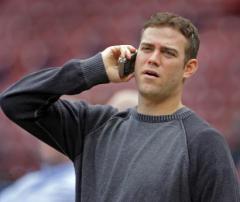 The day that Cubs fans have been anxiously awaiting since the team proved to be a flop may finally be here. Rumors of Anthony Rizzo being called up on Tuesday to get his first cracks against the Mets are picking up steam, and it would certainly be a logical time to bring the 22 year old up to the big leagues.
The day that Cubs fans have been anxiously awaiting since the team proved to be a flop may finally be here. Rumors of Anthony Rizzo being called up on Tuesday to get his first cracks against the Mets are picking up steam, and it would certainly be a logical time to bring the 22 year old up to the big leagues.
Hope is dwindling as the Cubs are currently sitting with half as many wins as losses at 24-48, any news circulating on the North Side these days is about players who could be leaving in a trade. The power numbers are especially abysmal, the team has only been able to put 57 balls over the fence and 263 men across the plate, good for the 24th and 26th ranks respectively in the MLB. Attendance still technically ranks the 7th best in the league, but those numbers deal in the number of tickets sold and not the number of fans actually filling the seats. Any fan who has watched a few home games can see that Wrigley field is not seating nearly 38,000 fans on a regular basis, the actual number may actually be half that many.
Enter Anthony Rizzo, who has hit 23 long balls to go along with 62 RBI in 69 games at triple A Iowa this season. Needless to say the hype machine has been whirring around Rizzo since he first landed in Chicago this offseason and has only augmented the buzz by putting up arguably the best numbers in the minors thus far. With all of that said, management will be doing the organization a great favor by putting Rizzo on the roster now instead of continuing to wait.
Some critics may remember the lack of success that plagued Rizzo in his 2011 stint with the Padres after putting up similar minor leagues. Rizzo hit 26 homers in 93 games and was called up to San Diego with big expectations, but he went on to hit .141 with only 1 home run in 49 games, much to the dismay of the Padre faithful. But the differences between the situations are numerous, and even if Rizzo goes on to have the same problems the Cubs will at least know exactly what to expect from what they perceive to be a top prospect that can develop into a franchise cornerstone.
One of the major changes for Rizzo will be in the ballparks where he spends most of his time. Going from the pitcher friendly Petco Park to Wrigley, which has days where the ball seems to be magnetically attracted to the outfield bleachers, is going to be both a stat and confidence booster for the young first baseman. This is also be Rizzo’s 5th year in the minors, the same amount of time that Adrian Gonzalez spent in development and significantly more than the minor league tenures of Albert Pujols or Prince Fielder. Right now the organization believes that Rizzo has the potential to be an elite first baseman, and so the developmental time should be right in line with that of other successful players at the same position. There’s also the more obvious fact that Rizzo is putting up huge numbers right now, and the team would have been hard pressed to hold back such a promising slugger even with some of his previous woes.
Like it or not, by this time next week Anthony Rizzo will most likely have completed his few games in Chicago and will be headed for many more this season. He may or may not have a breakout year in 2012, but odds are that Rizzo is going to produce now or never with the amount of time he’s spent as a professional. Now is the time for the Cubs to bring up Anthony Rizzo, and hopefully it will finally be his time to shine.



